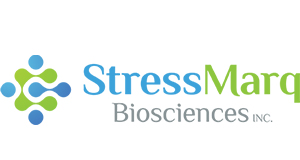Transthyretin L55P Variant Filaments
Human Recombinant Transthyretin L55P Variant Protein Filaments
SKU
STRSPR-464B
Packaging Unit
100 µg
Manufacturer
Stressmarq Biosciences
Availability:
loading...
Price is loading...
Target: Transthyretin (TTR)
Nature: Recombinant
Swiss-Prot: P02766
Expression System: E. coli
Protein Length: Full length
Purification: Ion-exchange Purified
Purity: >95%
Storage Buffer: PBS pH 7.4
Protein Size: 13.876 kDa
Conjugate: No Tag
Cellular Localization: Cytoplasm / Extracellular exosome / Extracellular Region / Lysosome
Scientific Background: Transthyretin is a transport protein in the serum and cerebospinal fluid that carried the thyroid hormone Thyroxine and retinol-binding protein bound to retinol. TTR misfolding and aggregation is known to be associated with the amyloiddiseases SSA, FAP and FAC (1-5). TTR is also thought to have beneficial side effects, such as binding to beta-amyloid protein, preventing beta-amyloid from accumulating into the plaques associated with Alzheimer's Disease (6). The L55P variant TTR is distinct from the other variants in that the L55P tetramer can dissociate to the monomeric amyloidogenic intermediate and form fibril precursors (7).
References: 1. Zeldenrust S.R., Benson M.D. (2010). Wiley. pp. 795–815. 2. Westermark P., Sletten K., Johansson B., Cornwell G.G. (1990). Proc. Natl. Acad. Sci. U.S.A. 87(7): 2843–5. 3. Andrade C. (1952). Brain. 75(3): 408–27. 4. Coelho T. (1996). Curr. Opin. Neurol. 9(5): 355–9. 5. Jacobson D.R, et. al. (1997). N. Engl. J. Med. 336(7): 466–73. 6. Li X. (2011). Mol Neurodegener. 6(1):79. 7. Lashuel H.A., Wurth C., Woo L., and Kelly J.W. (1999) Biochem. 38(41): 13560-13573.
Field of Use: Not for use in humans. Not for use in diagnostics or therapeutics. For research use only.
Nature: Recombinant
Swiss-Prot: P02766
Expression System: E. coli
Protein Length: Full length
Purification: Ion-exchange Purified
Purity: >95%
Storage Buffer: PBS pH 7.4
Protein Size: 13.876 kDa
Conjugate: No Tag
Cellular Localization: Cytoplasm / Extracellular exosome / Extracellular Region / Lysosome
Scientific Background: Transthyretin is a transport protein in the serum and cerebospinal fluid that carried the thyroid hormone Thyroxine and retinol-binding protein bound to retinol. TTR misfolding and aggregation is known to be associated with the amyloiddiseases SSA, FAP and FAC (1-5). TTR is also thought to have beneficial side effects, such as binding to beta-amyloid protein, preventing beta-amyloid from accumulating into the plaques associated with Alzheimer's Disease (6). The L55P variant TTR is distinct from the other variants in that the L55P tetramer can dissociate to the monomeric amyloidogenic intermediate and form fibril precursors (7).
References: 1. Zeldenrust S.R., Benson M.D. (2010). Wiley. pp. 795–815. 2. Westermark P., Sletten K., Johansson B., Cornwell G.G. (1990). Proc. Natl. Acad. Sci. U.S.A. 87(7): 2843–5. 3. Andrade C. (1952). Brain. 75(3): 408–27. 4. Coelho T. (1996). Curr. Opin. Neurol. 9(5): 355–9. 5. Jacobson D.R, et. al. (1997). N. Engl. J. Med. 336(7): 466–73. 6. Li X. (2011). Mol Neurodegener. 6(1):79. 7. Lashuel H.A., Wurth C., Woo L., and Kelly J.W. (1999) Biochem. 38(41): 13560-13573.
Field of Use: Not for use in humans. Not for use in diagnostics or therapeutics. For research use only.
| SKU | STRSPR-464B |
|---|---|
| Manufacturer | Stressmarq Biosciences |
| Manufacturer SKU | SPR-464B |
| Package Unit | 100 µg |
| Quantity Unit | STK |
| Reactivity | Human |
| Application | Western Blotting, In Vivo Assay, SDS-PAGE |
| Human Gene ID | 7276 |
| Product information (PDF) |
|
| MSDS (PDF) | Download |

 Deutsch
Deutsch










